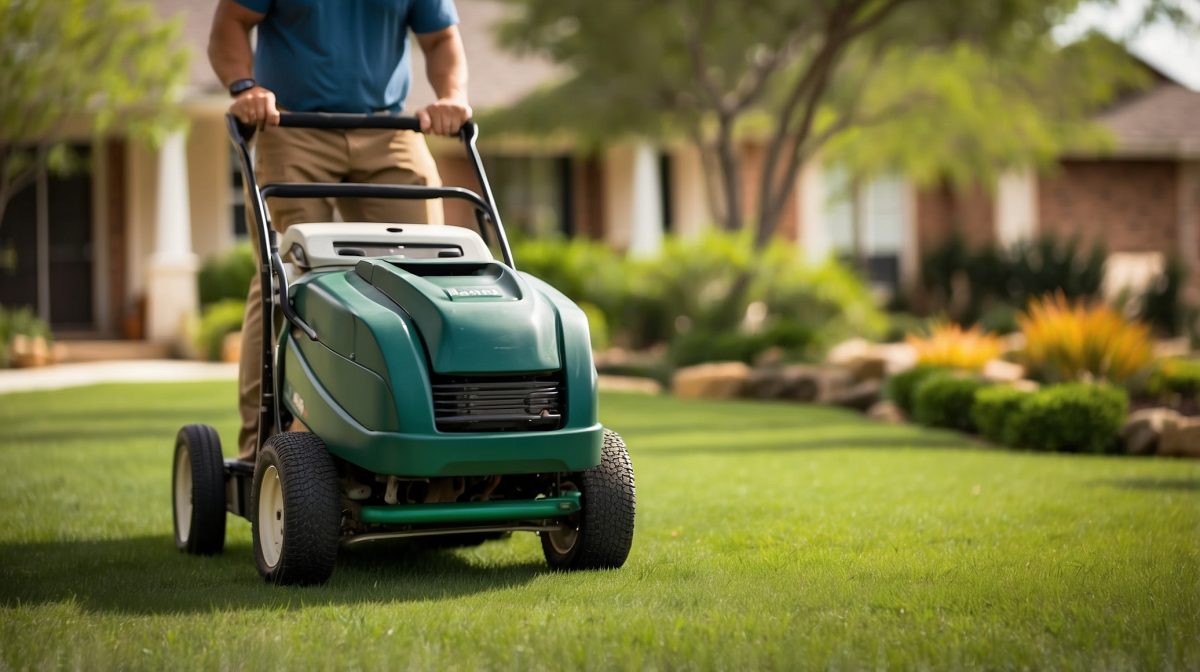Whether you’re a seasoned ranch hand or new to the Hill Country homestead life, understanding when and how to fertilize your lawn is key. It ain’t just about keeping up appearances; it’s about caring for the land that gives us so much. So, buckle up, because I’m about to share some tried-and-true tips that’ll have your lawn looking as hearty as a Texas-sized steak.
Understanding Texas Hill Country Climate
Now, the climate in these parts can be as unpredictable as a bull at a rodeo. We’ve got dry spells, sudden downpours, and everything in between. This variability can sure give your lawn a run for its money, making proper fertilization a mighty important task. It’s not just about when to fertilize, but also adapting to the whims of Mother Nature to keep your grass healthier than a prize heifer.
Your lawn’s health is directly tied to the weather patterns here in the Hill Country. With our scorching summers and occasional cold snaps, your grass has to be as tough as a pair of well-worn cowboy boots. Fertilization, when done right, can help your lawn withstand the elements and stay as lush as the green hills rolling towards the horizon.
Types of Grass in Texas Hill Country
Round these parts, we see a variety of grasses, each with its own particular charm. You might have Bermuda, St. Augustine, or Zoysia gracing your property, and each one’s got different needs, like folks at a potluck dinner. Knowing what’s underfoot is the first step to ensuring you’re giving your lawn the vittles it needs to thrive.
Bermuda grass loves the sun more than a cat on a windowsill, while St. Augustine will tolerate a bit of shade. Zoysia, now that’s a hardy middle-of-the-road kind of grass. Each type has its own schedule and appetite for nutrients, so you’ll need to tailor your fertilization strategy accordingly, making sure every blade gets the nourishment it needs to stand tall and proud.
The Right Time to Fertilize
Timing is everything, whether you’re branding cattle or fertilizing your lawn. Do it right, and you’ll have a lawn as robust as a longhorn. Miss the mark, and well, you might as well be spitting into the wind. Here in the Hill Country, we’ve got a rhythm to our seasons, and your fertilization efforts ought to match that tempo like a two-step on a Saturday night.
Springtime calls for a boost to wake up your grass from its winter slumber, while summer requires careful feeding to combat the heat. Come fall, it’s all about preparing for cooler temps, and in the rare times when winter shows its face, it’s mostly about maintenance. And keep an eye out for signs like underwhelming color or patchiness; they’re your lawn’s way of saying it’s hankering for some nutrients.
Choosing the Right Fertilizer
Just like picking the right saddle for a ride through the hills, choosing the right fertilizer for your lawn is crucial. It starts with getting to know your soil, testing its nutrients and pH levels to find out exactly what it’s craving. That’s the difference between a thriving lawn and one that’s just getting by. You wouldn’t feed a racehorse just any old feed, now would you?
When it comes to the showdown between organic and synthetic fertilizers, each has its merits for Hill Country lawns. Organic options are like slow-cooked brisket—gentle and wholesome over time. Synthetics are more like a jolt of espresso, quick and powerful. Whichever route you choose, make sure it’s in harmony with our local environment, nourishing your lawn without ruffling Mother Nature’s feathers.
How to Properly Apply Fertilizer
Applying fertilizer is like painting a masterpiece—it’s all in the technique. You want to spread it as evenly as the sunrise spreads light over the hills. I’ll walk you through it step by step, ensuring you don’t miss a spot or lay it on thicker than molasses. It’s all about that perfect coverage that’ll make your lawn as even as a dance floor at Gruene Hall.
After you’ve spread that fertilizer, watering practices are key. You’ve got to be as mindful as a gardener tending to her roses. Too much water, and you’ll wash all your hard work away; too little, and it won’t soak in deep. Just right, and your lawn will be sipping on those nutrients like a fine Texas wine, setting you up for success in the days to come.
Common Fertilizing Mistakes to Avoid
Even the best cowpoke can make a mistake or two when it comes to fertilizing. Overdoing it is like pouring too much hot sauce on your breakfast tacos—it can burn. Not only does over-fertilizing hurt your lawn, but it can also do a number on the local creeks and rivers, and we want to keep them as pristine as a Hill Country spring. So, mind the instructions on that fertilizer bag like it’s a treasure map.
If you do find yourself in a pickle, having laid the fertilizer on thicker than intended, don’t fret. There’s always a way to fix it, just like patching up an old fence. It might take a little elbow grease and patience, but with the right know-how, you can correct those errors faster than you can say “bluebonnet.”
Fertilizing and Lawn Maintenance Best Practices
Fertilizing is just one part of the grander lawn care waltz. To keep your lawn as vibrant as a field of Indian paintbrushes, you’ve got to integrate it with mowing, watering, and weeding practices. It’s about balance, like a well-tuned fiddle in a country band, each part working in harmony to create something beautiful.
And remember, there’s no shame in tipping your hat and asking for advice from a professional when needed. Sometimes, getting a bit of wisdom from a seasoned lawn care expert is just what the doctor ordered to keep your homestead looking as majestic as the Texas Hill Country itself.
Conclusion
We’ve covered a lot of ground, just like a cowboy on a long cattle drive. From understanding our unique climate to choosing the right fertilizer, we’ve laid out the best ways to care for your Texas Hill Country lawn. It’s a labor of love, but one that pays off with a yard as welcoming as a front porch light at dusk.
So, take these tips to heart, and let’s all do our part to keep the Hill Country looking as fine as a square dance on a Saturday night. Happy fertilizing, y’all!
FAQs
What’s the best time of day to fertilize my lawn in Texas Hill Country?
The best time of day is in the morning or late afternoon, avoiding the intense midday heat.
How often should I fertilize my lawn throughout the year?
Typically, fertilizing 2-3 times a year is sufficient, but it can vary based on grass type and soil conditions.
Can I fertilize my lawn during the Texas summer, or is it too hot?
It’s best to fertilize in early summer before the heat peaks, using a slow-release fertilizer to avoid burning the grass.
What should I do if my lawn doesn’t respond to fertilization?
Consult a lawn care professional to evaluate potential issues like soil health or pest problems.
Is it necessary to test my soil before choosing a fertilizer?
Yes, soil testing is recommended to determine the specific nutrients your lawn needs.


